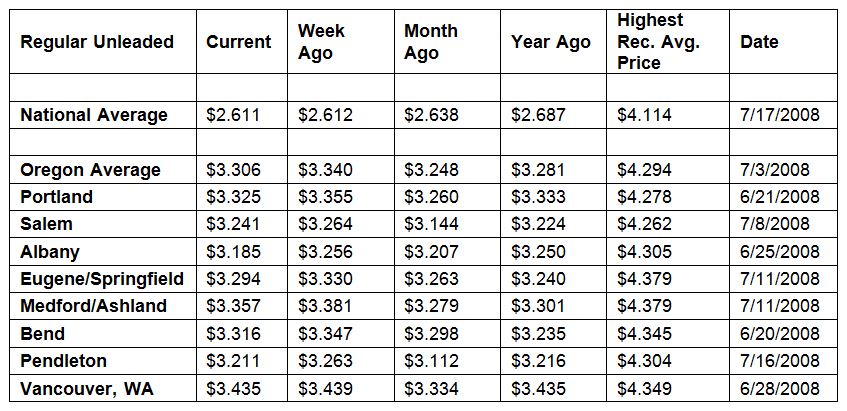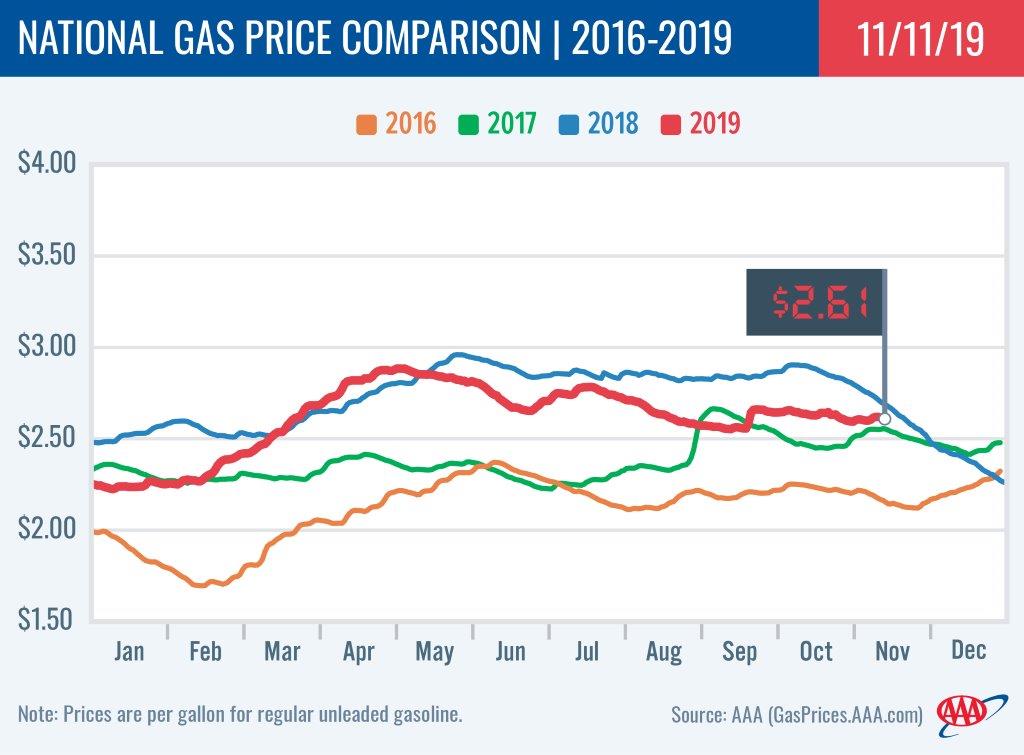PORTLAND, Ore., – Demand for gasoline in the U.S. is dropping to levels more typical for autumn which is helping pump prices fall or stabilize. For the week, the national average holds steady at $2.61 a gallon. The Oregon average loses three cents to $3.31.
The latest report from the U.S. Energy Information Administration (EIA) shows that gasoline demand is reflecting the most fall-like numbers (9.1 million b/d) since the end of September. Despite lower demand, stocks decreased by a significant 2.8 million bbl in part due to high exports.
“After a wild ride the last few weeks, pump prices are finally settling down in most states, including Oregon. Drivers can expect small changes at the pumps in the next couple weeks instead of dramatic shifts in prices,” says Marie Dodds, public affairs director for AAA Oregon/Idaho.
Oregon is one of 21 states where prices are lower now than a week ago. Indiana (-5 cents) has the largest week-over-week decline, followed by California (-4 cents) and Florida (-4 cents). Utah (+8 cents) has the biggest weekly jump, followed by Idaho (+4 cents) and Arizona (+3 cents). Prices are flat in Minnesota and Mississippi.
This week there are six states with an average above $3 a gallon, same as a week ago. California ($4.03) remains the only state in the nation with an average above $4 and has been above the $4 mark for seven consecutive weeks.
Oregon is one of 24 states and the District of Columbia with higher prices now than a month ago. The national average is three cents less and the Oregon average is 6 cents more than a month ago. This is the seventh-largest monthly increase in the nation. Idaho (+22 cents) has the largest month-over-month increase and Alaska (+15 cents) is second. Ohio (-16 cents) has the largest month-over-month decline.
Oregon is one of only seven states where drivers are paying more than a year ago. The national average is eight cents less and the Oregon average is three cents more than a year ago. California (+34 cents) and Nevada (+12 cents) have the biggest year-over-year increases. Rhode Island (-25 cents) has the largest year-over-year drop.
West Coast
The West Coast continues to have the highest pump prices in the nation with all of the region’s states landing on the top 10 most expensive list.
| Rank | Region | Price on 11/12/19 | |
| 1 | California | $4.03 | |
| 2 | Hawaii | $3.66 | |
| 3 | Washington | $3.41 | |
| 4 | Nevada | $3.37 | |
| 5 | Oregon | $3.31 | |
| 6 | Alaska | $3.18 | |
| 7 | Idaho | $3.00 | |
| 8 | Arizona | $2.95 | |
| 9 | Utah | $2.91 | |
| 10 | Colorado | $2.80 |
California is most expensive for the eighth week in a row, with Hawaii, Washington, Nevada, Oregon, and Alaska rounding out the top six. Oregon is fifth most expensive for the 17th week in a row. Arizona is eighth.
Pump prices in the West Coast region have mostly decreased on the week after the region underwent planned and unplanned refinery maintenance that caused prices to spike over the past month. Reduced supply in the region, amid robust demand, sent pump prices climbing, but now prices are easing as a result of imports and increased production from regional refineries.
California (-4 cents) and Oregon (-3 cents) have the largest weekly declines in the region. Arizona (+3 cents) has the largest increase on the week.
The EIA report for the week ending November 1, showed that total West Coast gasoline stocks decreased moderately from 26.44 million bbl to 26.19 million bbl. The current level is approximately 1.16 million bbl lower than this same time last year. This could cause prices to climb again if there’s another supply disruption in the region.
The cheapest gas in the nation can be found in Louisiana ($2.22) and Mississippi ($2.23). For the 39th week in a row, no states have an average below $2 a gallon.
Oil market dynamics
Crude oil prices increased last week as a result of increased optimism that China and the U.S. – the world’s two largest crude consumers – are continuing to resolve ongoing trade tensions. The trade conflict had previously sparked market fears that global crude demand would suffer as a result of increased tariffs between both countries. If trade relations between the U.S. and China continue to show improvement this week, crude prices may continue to increase.
In related news, EIA’s most recent weekly report showed that total domestic crude inventories increased by 7.9 million bbl last week, bringing the new total to 446.8 million bbl. The current level is 15 million bbl higher than last year’s level at this same time.
At the close of Friday’s formal trading session on the NYMEX, WTI increased by nine cents to settle at $57.24. At the close of Monday’s formal trading session on the NYMEX, WTI fell 38 cents to close at $56.86. Today crude is trading around $57, same as a week ago. Crude prices are up about six percent in the last month and are about $4 per barrel less than a year ago.
Drivers can find current gas prices along their route with the free AAA Mobile app for iPhone, iPad and Android. The app can also be used to map a route, find discounts, book a hotel and access AAA roadside assistance. Learn more at AAA.com/mobile.
Diesel
For the week, the national average adds half a cent to $3.01 a gallon. Oregon’s average slips half a cent to $3.49. A year ago the national average for diesel was $3.25 and the Oregon average was $3.43.
Find current fuel prices at GasPrices.AAA.com.
AAA news releases, high resolution images, broadcast-quality video, fact sheets and podcasts are available on the AAA NewsRoom at NewsRoom.AAA.com.
Find local news releases at https://www.oregon.aaa.com/category/news-releases/



